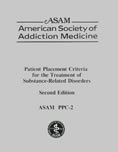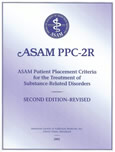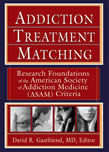![]()
The ASAM PPC-2R is best known as a paper document that stages addictive disease, provides guidelines as to the type of intensity of care, and systematizes the care of clients and patients who suffer from addictive disease. Use of the PPC is mandated in many states across the United States, and its use has spread to over 30 counties across the globe. The PPC-2R assessment system has evolved in stages, from a paper document, to a validated assessment prototype, and finally to an assessment software system. The paper document defines systematic rules to determine the proper type of care that is needed based upon a patient's current mental, emotional, and social situation. The PPC evaluates a patient's needs regarding addiction and its co-existing mental, emotional, and medical diseases. The PPC is the first instrument to codify the types and intensity of addiction treatment and to apply a systematic method of analyzing a patient;s needs for care.
The development of the criteria started over 20 years ago. During that time, the PPC evolved from a set of criteria to a cohesive assessment and treatment staging system. The highlights of its history are described below.
The Cleveland Criteria Developed at the request of the Northern Ohio Chemical Dependency Treatment Directors Association, the "Cleveland Criteria" were designed by a team of consultants coordinated by the Chemical Abuse Treatment Outcome Registry (CATOR). Members of the steering committee that guided the project represented treatment programs and other interested organizations in northern Ohio. The authors of the Cleveland Criteria were Norman G. Hoffmann, Ph.D., James A. Halikas, M.D., and David Mee-Lee, M.D. The criteria were documented in a 1990 report by the Institute of Medicine of the National Academy of Sciences, entitled "Broadening the Base of Treatment for Alcohol Problems, the Cleveland Criteria." The criteria were a significant contribution to the addiction field and provided a springboard for treatment evaluation and assessment studies to follow.
The NAATP Criteria In the second effort, a work group composed of providers and consultants, coordinated by Richard D. Weedman, M.S.W., FACATA, of Healthcare Network, Inc., used all criteria sets available at the time to produce the National Association of Addiction Treatment Providers (NAATP) Patient Placement Criteria. These criteria were used by approximately 210 publicly and privately funded addiction treatment programs to enhance their internal utilization review and case management systems and to guide their clinical decision-making processes. By the end of the 1980s, 40 to 50 sets of criteria were in use by various insurers and utilization management firms in the private sector. Many of these criteria varied sharply in their guidance as to assessment and placement, and some even directly contradicted others. This patchwork caused confusion where consensus was desperately needed.
The NAATP-ASAM Collaboration This work led to a third project in which NAATP and the American Society of Addiction Medicine recruited a representative group of addiction experts to develop adult and adolescent criteria based on the Cleveland Criteria and the NAATP Criteria. The project resulted in the identification and description of four levels of treatment, which were differentiated from each other by the following characteristics: Degree of direct medical management provided; Structure, safety and security provided; and the intensity of treatment services provided. The drafters also identified and described six patient dimensions that could be used to differentiate patient needs for services across the four levels of care. The result of these efforts was compiled in the Patient Placement Criteria for the Treatment of Psychoactive Substance Use Disorders, which was published by the American Society of Addiction Medicine in 1991. This went on to be known as the PPC-1.
 The Second Edition of the PPC was published in 1996. The PPC-2 refined the criteria to consider multiple dimensions of assessment, clinically-determined treatment, variable length of stay and a better definition of a continuum of care. The PPC-2 defined six areas or dimensions of assessment:
The Second Edition of the PPC was published in 1996. The PPC-2 refined the criteria to consider multiple dimensions of assessment, clinically-determined treatment, variable length of stay and a better definition of a continuum of care. The PPC-2 defined six areas or dimensions of assessment:
- Dimension 1 - Acute Intoxication and/or Withdrawal
- Dimension 2 - Biomedical Conditions and Complications
- Dimension 3 - Emotional/Behavioral Conditions and Complications
- Dimension 4 - Treatment Acceptance/Resistance
- Dimension 5 - Relapse / Continued Use Potential
- Dimension 6 - Recovery Environment
The PPC-2 introduced more granularity in the levels of care. The major levels of care were modified form the PPC-1 to:
- Level 0.5, Early Intervention
- Level I, Outpatient Treatment
- Level II, Intensive Outpatient/Partial Hospitalization
- Level III, Residential / Inpatient Treatment
- Level IV, Medically-Managed Intensive Inpatient Treatment
Within these broad levels of service is a range of specific levels and types of care. The PPC-2 contained two sets of guidelines, one for adults and one for adolescents. For each level of care, the paper product supplies a brief overview of the services available for particular severities of addiction and related problems is presented; as is a structured description of the settings, staff and services, and admission criteria for each of the six dimensions
 The Second Edition, Revised of the PPC was published in 2001. The diagnostic terminology used in the ASAM PPC-2R is consistent with the most recent language of the American Psychiatric Association's Diagnostic and Statistical Manual of Mental Disorders (DSM-IV). The "unbundling" of clinical services is addressed, recognizing that these services can be and often are provided separately from environmental supports. With unbundling, the type and intensity of treatment are based on the patient's needs and not on limitations imposed by the treatment setting. Criteria are also included to match a patient's severity of illness along Dimension 1 (Acute Intoxication and/or Withdrawal Potential) with five intensities of detoxification service.
The Second Edition, Revised of the PPC was published in 2001. The diagnostic terminology used in the ASAM PPC-2R is consistent with the most recent language of the American Psychiatric Association's Diagnostic and Statistical Manual of Mental Disorders (DSM-IV). The "unbundling" of clinical services is addressed, recognizing that these services can be and often are provided separately from environmental supports. With unbundling, the type and intensity of treatment are based on the patient's needs and not on limitations imposed by the treatment setting. Criteria are also included to match a patient's severity of illness along Dimension 1 (Acute Intoxication and/or Withdrawal Potential) with five intensities of detoxification service.
There are significant additional criteria and appendices in the 2R version that will assist both the addiction treatment and mental health fields improve services for people with co-occurring mental and substance-related disorders. The 2R version responded to requests for criteria that better meet the needs of patients with co-occurring mental and substance-related disorders ("dual diagnosis"), for revised adolescent criteria and for clarification of the residential levels of care.
Increasing numbers of states require that treatment providers utilize the PPC for their level of care determinations. The PPC-2R has become so synonymous for the mission of ASAM that you will hear people talk of the PPC as the ASAM Criteria, or even "The ASAM." The PPC capitalizes on the growing awareness that mental health care needs to be systematized and codified.
Mandating the use of the paper version of the PPC, however, did little to systematize treatment. The paper product is a description of how to segment care and a general method of approaching addiction care. Many treatment providers call themselves "PPC Compliant" with little understanding of what the PPC is. To further systematize the PPC, and instrument needed to be built that assessed patients according to the paper criteria and placed such patients in a level and type of care. Then, the placement and the resultant care should be assessed as to its efficacy both in terms of outcome and efficiency (financial and otherwise).
 Since the publication of the PPC-1, the PPC has been the subject of hundreds of research studies. Many studies have determined the efficacy of using the PPC to determine care needs for many disparate populations of individuals with disparate needs. Researchers from the United States, Belgium, Norway, Iceland, Israel, Canada and other countries across the globe have studied the PPC. Recent research on the PPC is summarized in collection of articles published in Addiction Treatment Matching edited by David Gastfriend, M.D.
Since the publication of the PPC-1, the PPC has been the subject of hundreds of research studies. Many studies have determined the efficacy of using the PPC to determine care needs for many disparate populations of individuals with disparate needs. Researchers from the United States, Belgium, Norway, Iceland, Israel, Canada and other countries across the globe have studied the PPC. Recent research on the PPC is summarized in collection of articles published in Addiction Treatment Matching edited by David Gastfriend, M.D.
The need for a clinical tool that implements the rules set forth in the paper version of the PPC led to the development of the PPC-2R assessment software system. The PPC-2R assessment software system is a collaborative effort between private industry (CMHC Systems, Inc.) researchers (primarily the Massachusetts General Hospital / Harvard Addiction Research Program headed by David Gastfriend, M.D.). The original prototype research on the PPC-2R project was partly funded by NIAAA SBIR grant R44 AA12004 to Earley Corporation. The company has since been merged into Creative-Sociomedics, Inc.
The PPC software system took many years to develop. In the software questionnaire items are connected with clinical rules in the PPC paper product. The questionnaire items are asked using computer-guided control. If a patient responds positively to an introductory question, the computer probes deeper into the patient's clinical history. When the computer-guided structured interview is complete, the clinician completes (posts in PPC-lingo) the assessment. Then the computer goes to work running through almost 6,000 decision rules to arrive at suggestions regarding the client or patient's diagnosis, need for detoxification, need for medical attention and recommends one or more initial types and levels of care.
The software was designed to be readily expandable and responsive to changes in PPC research. When the product was tested in the U.S. and abroad, it was found to serve research needs but proved to be too exhaustive for routine use in a day-to-day clinical setting. In response, the authors of the software (Earley. Lefebvre, and Gastfriend) teamed up with one of the authors of the PPC-2R manuscript (Mee-Lee) to develop a triage tool. The triage tool is currently in development. We will announce additional information about the triage tool here on this web site. Please check back for additional information in the near future.